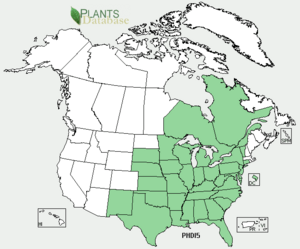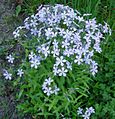Wild blue phlox facts for kids
Quick facts for kids Wild blue phlox |
|
|---|---|
 |
|
| Conservation status | |
| Scientific classification | |
| Genus: |
Phlox
|
| Species: |
divaricata
|
 |
|
| Natural range in North America | |
Phlox divaricata, also called wild blue phlox or woodland phlox, is a beautiful flowering plant. It grows naturally in forests and fields across eastern North America. This plant is known for its lovely blue, purple, pink, or white flowers that have a sweet smell.
Contents
What's in a Name?
The scientific name divaricata means "spreading out". This describes how the plant grows, with its stems and branches spreading wide.
About the Wild Blue Phlox
Wild blue phlox is a plant that lives for many years. It stays green for most of the year, even in winter. It usually grows about 25 to 50 centimeters (10 to 20 inches) tall.
- Leaves: The leaves are hairy and grow in pairs along the stem. They are about 2.5 to 5 centimeters (1 to 2 inches) long.
- Flowers: The pretty flowers appear in late spring and early summer. They are usually 2 to 4 centimeters (1 to 1.5 inches) wide. Each flower has five petals that are joined at the bottom to form a long, thin tube.
There are two main types of wild blue phlox:
- ssp. divaricata: This type has petals with a small notch or dip at the very tip.
- ssp. laphamii: This type has petals that are smooth and do not have a notch at the tip.
How Phlox Flowers Get Pollinated
The flowers of wild blue phlox make two important things:
- Nectar: This sweet liquid is found deep inside the flower's long tube.
- Pollen: This powdery substance is found closer to the opening of the flower.
Only insects with long tongues, like butterflies, moths, and some bees, can reach the nectar. Shorter-tongued bees and other flies might visit the flower to collect pollen, but they can't get to the nectar.
Wild blue phlox needs help from insects to make seeds. It cannot pollinate itself. This means pollen must be moved from one phlox plant to another. Butterflies are very good at this job. When a butterfly puts its long tongue into a flower to drink nectar, pollen sticks to its tongue. As the butterfly moves to another phlox flower, some of that pollen falls off onto the new flower, helping it make seeds.
Different Kinds of Phlox
Gardeners have grown many different types of wild blue phlox. These are called "cultivars." They come in various colors:
- 'Blue Moon' (blue)
- 'Clouds of Perfume' (lavender)
- 'Fuller's White' (white)
- 'White Perfume' (white)
The 'Chattahoochee' cultivar, which has lavender flowers, has even won a special award for being a great garden plant!
See also
 In Spanish: Phlox divaricata para niños
In Spanish: Phlox divaricata para niños








